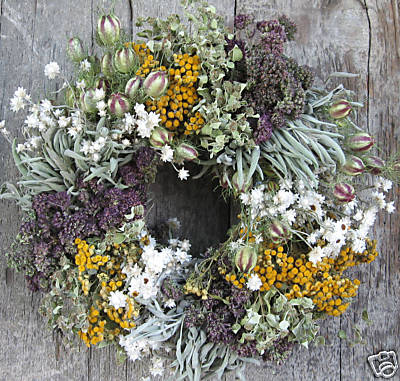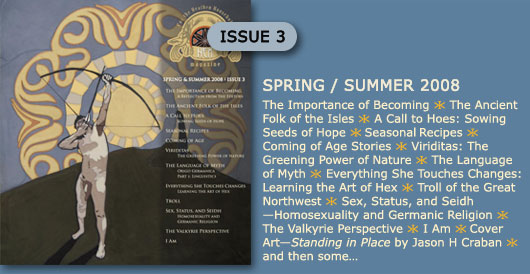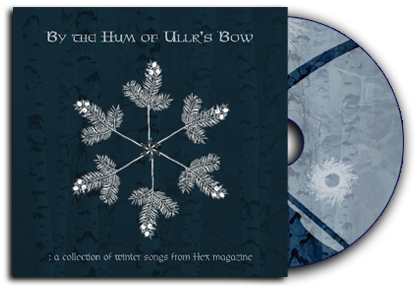~ THE TURNING OF THE WHEEL ~
Summer Solstice 2010
Issue #6 is Here!
Support Hex!
We are community-supported not-for-profit publication. You can
support us by clicking the image above and ordering magazines, CDs,
and prints, and by spreading the word to all like-minded folk!
* * * * * *
* New Hex Website Almost Here! *
That’s right folks, we’ve been hard at work rebuilding the website to feature mountains of online content, book and music reviews, and a more interactive format…we’ll let you know as soon as the new site is up. Exciting times for Hex Magazine!
* * * * * *

Summer Solstice Herb Lore
Summer Solstice marks the longest day and shortest night of the year. At this time the sun/Sunna is at the peak of power on earth/Midgard in the Northern Hemisphere, and Mother Earth/Nerthus is doing her best to make use of as much of Sunna’s power as she can.
As a result most of the plants/worts are at, or are approaching, their peak of growth. Their leaves are full and robust, while flowers of all kinds bloom or get ready to bloom in anticipation of fertilization which will allow the setting of the seeds of future generations.
In Heathen lands, and all across the Northern Hemisphere, the harvesting of many of these worts was said to best be accomplished on Midsummer Eve or Midsummer Day. In Denmark for example it is said that “all herbs, good and bad, grow out of the grass on Midsummer Eve endowed with special powers, beneficent or the reverse…[and] when picked at noon on midsummer day or eve, they have extra virtues.”[1]
These specially picked Midsummer worts were not only used as peak flavor seasonings, but as medicinals, and just as importantly as tools in warding homes, people, animals, and even the fields from ill willing folk, both human and otherwise. One popular way to utilize the worts was to decorate “June-poles” and they were also used for the crafting of wreaths to decorate doors, windows, and hearths.
John Stowe in his Survey of London, c. 1598, says this about the Midsummer decorations of that time: “every man’s door being shadowed with green birch, long fennel, saint john’s wort, or pine and white lillies, and such like, garnished upon with garlands of beautiful flowers… brought in green boughs and flowers to “make therewith houses gay…”[2]
If you’ve ever wondered when would be the best time to harvest all those herbal worts you’ve been collecting, this is it. Even if you don’t grow herbs you can still harvest worts as Heathens have done for countless generations.
Harvesting most herbs is pretty simple. In the morning after the dew has dried cut off from one-half to one-third of the chosen wort. Gather the cut ends and tie tightly together. Handle the worts upside down in a dark and dry area, away from too much dust. Check the worts’ texture regularly and when they are dry to the touch remove the dried leaves carefully and store in a well labeled, airtight container away from sunlight for future use. Or if you have one, use a food dehydrator.
Many worts have been associated with Midsummer in one way or another from various sources. Pine cones were noted as something to collect and keep at this time for protection, for fertility, and for virility. St. John’s Wort would be gathered on Midsummer eve and made into garlands believed to protect the wearer against all manner of evil. Sometimes worts were collected to burn on the balefires of the season like mullein, larkspur, St. John’s Wort, mugwort, yarrow, centaury, rue, basil, henbane, mandrake, and pansy. Fungi might also be burned to protect against the power of trolls.
Other worts were used as divination tools. If yarrow were picked it could be placed under a girl’s pillow and in turn she would dream of her future husband. While roses gathered of Midsummer Eve…could foretell a future lover’s identity.
At Midsummer you might consider using old herbal worts from the kitchen (those purchased more than a year ago or even from last year if you are replacing them this year) to create herbal charms to toss into the Midsummer Fire.
“In Germany people on this occasion wore chaplets of mugwort…[and] as each departed, he threw the mugwort into the fire, saying; “May all my ill-luck depart and be burnt up with these.”[3, Ch 5.3]
Often the bale fires were said to contain nine kinds of wood as blessing or warding. In Baden the children collected fuel from house to house for the midsummer bonfire on St. John’s Day; if a man contributed nothing to the bonfire, it was imagined that there would be no blessing on his crops, and that his hemp in particular would never grow.[3, Ch 5.6]
At our own homes we can try to find nine woods and bundle them together for the Midsummer fire. Or each family or person attending a Midsummer fire celebration could bring wood from their own homes to the festivities.
Taking some time to get to know the worts near us can be a great way to connect with Nerthus, Midgard, and our ancestors. Can you identify nine types of wood growing near your home? How about nine blooming plants or nine shrubs or useful weeds/worts? Give it a try. Once you can identify them look for a good use or two for them.
May your Midsummer be blessed with good folk, good food, good frith, and good fun!
~ Teresa Luedke
[1] Littell, Eliakim. Robert S. Littell. The Living Age Volume 254, Making of America Project, 1899.
[2] Stow, John. British History Online: A Survey of London – reprinted from the text of 1603 &1598. http://www.british-history.ac.uk/source.aspx?pubid=593
[3] Frazer, James. The Golden Bough, 1922. http://www.bartleby.com/196/156.htm
* * * * * *

•LAGUZ•
Old English Rune Poem
Lagu (Sea) is by folk thought wide indeed,
If they should dare to go in a ship unsteady,
And the waves terribly frighten them,
And the sea-stallion heed not its bridle.
Old Icelandic Rune Poem
Logr (Sea) is a welling water
And a wide kettle
And a fish’s field
Old Norse Rune Poem
Logr (Water) is, when falling out of a mountain, a cascade;
And costly ornaments are of gold.
~ Rune poem translations by Sweyn Plowright
http://www.mackaos.com.au/Rune-Net/Primer/
Laguz is my favourite rune. There I’ve said it, I play runic favourites! Midsummer is famously liminal, a time when our dreams are particularly loaded with meaning. I’ve found Laguz to be a rune that transforms through the watery mystery of dreaming and I’d like to share just how that personal theory has come to be.
Some 10 years ago my life stumbled into a dark and stagnant place and I found myself stripped of hope, self-confidence, and vision for any kind of future. In my need I sought out spiritual aid, but the aid that came was not anything that I could have created of my own isolated will.
What came to me was Laguz. The rune appeared everywhere as I wandered the city, trying to assemble the fragments of my life. It lurked scratched in the footpath; woven into ornamented awnings; in decorated windows; and as graffiti on dingy walls. In its arguable alter-ego as the leek it seemed to reliably and conspicuously pop up on specials boards in restaurants and shops that I would wander past.
One night Laguz swept me up and spoke to me, told me to follow its lead so that I might learn a thing or two. Bewildered, I trailed the nagging call that it put out. Every time I came to a street, the lights would change at just the right time and I would keep walking. Every time I came to a junction or intersection people and vehicles around me would arrange themselves so that I was seamlessly moved in this or that particular direction.
This journey led me to a pool, a public monument to memory, and in my waking dream it was the Well of Mimir that Laguz had welled from and returned me to. And truly the weight of my despair was lifted by this gift of remembrance – remembrance that “magic” does happen and we are not condemned to be alone on the vast sea of life if we do not wish to be.
It was my first ever experience of will-less will, the idea of allowing the greater tides of the world to flow through one. The idea that one can be consistently in just the right place at the right time and it can be easy, fluid. The discovery that at some point heroic striving becomes little more than creating resistance and friction against oneself and the world around.
This was deeply transformative, because it showed me that perhaps I could have faith in both myself and the world around me. I have a lot more to learn about this sort of impeccable effortlessness (perhaps it could be dubbed active inaction), and in a way I am only beginning on this journey. But those experiences with Laguz were an invitation into a far more hale life and surely guided me onto a better path.
The Laguz-ocean is wide and terrifying to those who venture out in an unsteady ship – and truly, all ships are unsteady, for we are but mortals, made to die, in an unimaginably vast universe.
Yet Laguz teaches the way for us to cope with this awesome challenge: not to harden into stones (which sink all too easily), but rather to tap into our sense of dreaming and trusting that where disembodied will cannot force the sea steed to heed its bridle – there instead the gold that hides beneath the mountain cascade of our consciousness can come into its own.
I truly believe that the image of Laguz as the cascade, with costly ornaments implied beneath as hidden treasure, is a useful metaphor for our relationship to our own unconscious minds, which of course in turn flow into the deeper patterns of wyrd and örlog. At Midsummer, dreams open us more fully to those riches, so that they can even make our waking life dream-like. And surely when dreams and waking become aligned beautiful things can unfold.
For dreams are not just arbitrary fancy, but perhaps are the fabric from which the whole world is woven: to me personally Laguz, the water rune, is also the rune of dreaming.
* * * * * *
By the Hum of Ullr’s Bow: Winter Songs Compilation CD is still available!
Bands on the compilation CD include:
• A Minority of One • Allerseelen • Andrew King • At the Head of the Woods • Beastianity
• Hamramr • Irij • Ironwood • Ruhr Hunter • Sangre Cavallum • Sieben • Steve von Till
• Svarrogh • Waldteufel • Wardruna
(You can read more about the artists here).
: Issue Three Almost Gone! :

Issues One, Two, Four, & Five are sold out!
Limited numbers of Hex Issue Three (Issue Six also still available of course!) remain…
Order at:
* * * * * *
Until Summer Solstice, may you and your
household be blessed and kept. Hail!
~ HEX Magazine
* * * * * *
We are currently looking for:
• submissions
• funding
If you are interested in applying or have any suggestions, contact: info@hexmagazine.com
* * * * * *
Due date for Spring 2011 submissions is Autumn Equinox 2010
Support your community while exposing like-minded
folk to your goods and services…
Advertisements must be relevant to HEX readers, and inclined toward a Heathen aesthetic. Prices listed are for completed AD files. If you need additional graphic design, we can help. Just contact us about our design fee.
AD space is now available in the newsletter for $10 a run.
Contact info@hexmagazine.com if you are interested.
>I< HEX >I<
> Please forward to all interested and relevant parties <












Leave a Reply